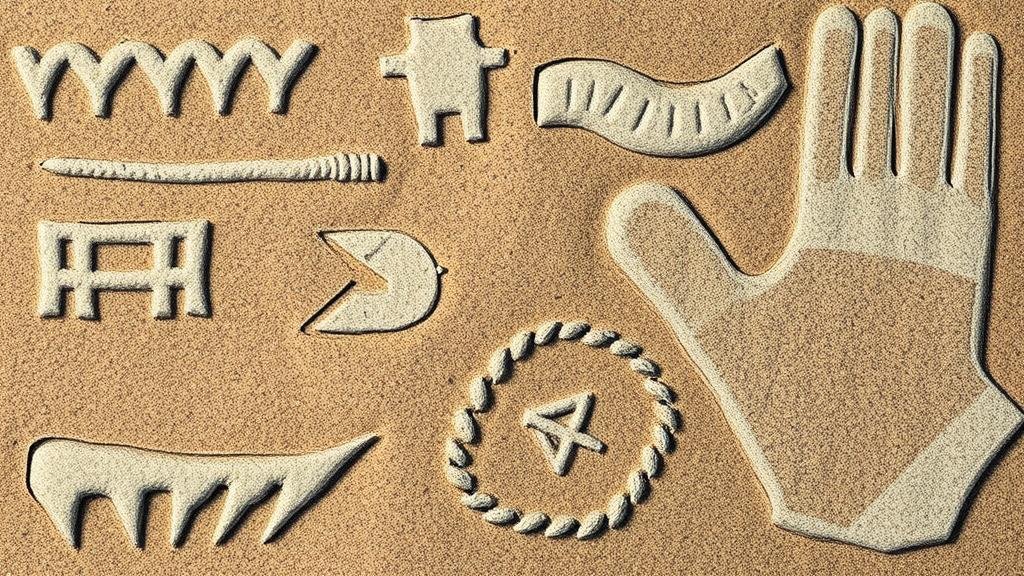How to Recognize Ancient Hand Tool Marks on Rocks as Clues for Nearby Relics
How to Recognize Ancient Hand Tool Marks on Rocks as Clues for Nearby Relics
The study of ancient hand tool marks on rocks can provide valuable insights into prehistoric human activity. Recognizing these marks not only contributes to our understanding of ancient technologies but also aids in discovering potential nearby artifacts or remnants of human habitation. This article will delve into the techniques for identifying these tool marks, their significance, and how they may indicate the proximity of relics.
The Nature of Tool Marks
Ancient hand tool marks on rocks result from various activities, including manufacturing tools, creating shelter, or processing food. e marks are often discerned through their unique shapes, sizes, and patterns, which correspond to specific tools and techniques used by ancient peoples.
Common types of hand tools used in ancient times included:
- Choppers: These tools exhibit broad, shallow grooves, indicative of heavy impact.
- Axes: Marks from axe tools usually display distinctive wedge shapes or fine scratches.
- Flakes: These demonstrate a pattern of shattering, often resulting in sharp edges.
Understanding Tool Mark Patterns
Recognizing and interpreting tool mark patterns is crucial for identifying ancient interactions with stone materials. Tool marks can show the nature of the activity performed, the type of tool used, and may even hint at the cultural context of the individuals who created them.
Some key patterns to look for include:
- Striations: Fine lines that may indicate scraping or cutting actions.
- Conchoidal Fractures: Smooth, curved marks indicating the use of percussion flaking techniques.
- Rubbing Marks: Signs of grinding or polishing that suggest later stages of tool manufacture.
Case Studies of Tool Mark Identification
In various archaeological sites around the world, the presence of tool marks has been instrumental in unraveling prehistoric activities. A notable example is the findings at the Olduvai Gorge in Tanzania, where the examination of stone tools led researchers to identify specific hand tool marks indicative of various manufacturing processes.
Another significant case involves the Lascaux Caves in France, where ancient cave paintings coexist with identifiable tool marks. e marks were used to create stencils and possibly prepare surfaces for painting, signifying a cultural practice rather than mere survival. The correlation between tool marks and nearby artifacts in these cases has proven crucial for understanding the social behaviors of early humans.
The Importance of Context
Context is paramount when it comes to recognizing hand tool marks and associating them with nearby relics. The geological setting, the proximity to water sources, and the surrounding artifacts all play a role in painting a fuller picture of ancient lifestyles.
For example, sites near riverbanks often bear marks from tool-making due to the availability of raw materials. Excavations at such locations have yielded stone tools along with remains of food processing, indicating a sustained human presence. On the other hand, isolated tool marks in remote areas may suggest temporary usage or specialized activities. So, understanding the spatial relationships of the marks to their environment is key for archaeologists.
Techniques for Field Identification
When examining rocks for ancient hand tool marks in the field, several systematic techniques exist:
- Visual Inspection: Start with a careful examination of rock surfaces using natural lighting to enhance visibility.
- Photography: Document findings using high-resolution images to capture details that may assist later analyses.
- 3D Scanning: Consider using technology such as 3D scanning for detailed measurements of tool marks, allowing for comparison and further study.
Potential Questions and Considerations
It is natural to have concerns about distinguishing authentic ancient tool marks from natural rock features. For example, naturally occurring erosional patterns may appear similar to tool marks but lack coherence or the stratification found in man-made patterns. Engaging with a professional archaeologist or using comparative studies from literature can clarify distinctions.
Actionable Takeaways
Recognizing ancient hand tool marks on rocks can be both a scientific investigation and a rewarding pursuit for enthusiasts. Here are some actionable takeaways:
- Learn and familiarize yourself with the types of marks associated with various tools.
- Use systematic methods to document and analyze marks found in the field.
- Engage in community archaeology groups for collaborative learning and potential discoveries.
By employing diligence and a keen eye for detail, anyone can contribute to the understanding of ancient human activity through the expert recognition of tool marks, opening paths to uncovering the stories of our forebearers.



